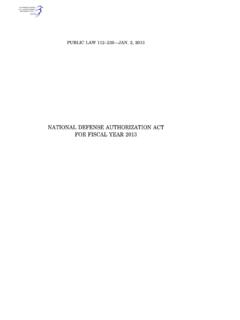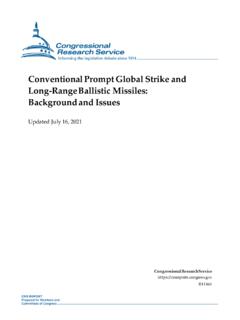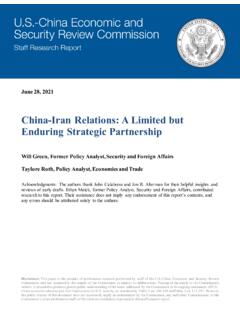Transcription of Hypersonic Weapons: Background and Issues for Congress
1 Hypersonic Weapons: Background and Issues for Congress Updated October 19, 2021 Congressional Research Service R45811 Congressional Research Service SUMMARY Hypersonic Weapons: Background and Issues for Congress The United States has actively pursued the development of Hypersonic weapons maneuvering weapons that fly at speeds of at least Mach 5 as a part of its conventional prompt global strike program since the early 2000s. In recent years, the United States has focused such efforts on developing Hypersonic glide vehicles, which are launched from a rocket before gliding to a target, and Hypersonic cruise missiles, which are powered by high-speed, air-breathing engines during flight.
2 As Vice Chairman of the Joint Chiefs of Staff and former Commander of Strategic Command General John Hyten has stated, these weapons could enable responsive, long-range, strike options against distant, defended, and/or time-critical threats [such as road-mobile missiles] when other forces are unavailable, denied access, or not preferred. Critics, on the other hand, contend that Hypersonic weapons lack defined mission requirements, contribute little to military capability, and are unnecessary for deterrence. Funding for Hypersonic weapons has been relatively restrained in the past; however, both the Pentagon and Congress have shown a growing interest in pursuing the development and near-term deployment of Hypersonic systems.
3 This is due, in part, to the advances in these technologies in Russia and China, both of which have a number of Hypersonic weapons programs and have likely fielded operational Hypersonic glide vehicles potentially armed with nuclear warheads. Most Hypersonic weapons, in contrast to those in Russia and China, are not being designed for use with a nuclear warhead. As a result, Hypersonic weapons will likely require greater accuracy and will be more technically challenging to develop than nuclear-armed Chinese and Russian systems. The Pentagon s FY2022 budget request for Hypersonic research is $ billion up from $ billion in the FY2021 request. The Missile Defense Agency additionally requested $ million for Hypersonic defense.
4 At present, the Department of Defense (DOD) has not established any programs of record for Hypersonic weapons, suggesting that it may not have approved either mission requirements for the systems or long-term funding plans. Indeed, as Principal Director for Hypersonics (Office of the Under Secretary of Defense for Research and Engineering) Mike White has stated, DOD has not yet made a decision to acquire Hypersonic weapons and is instead developing prototypes to assist in the evaluation of potential weapon system concepts and mission sets. As Congress reviews the Pentagon s plans for Hypersonic weapons programs, it might consider questions about the rationale for Hypersonic weapons, their expected costs, and their implications for strategic stability and arms control.
5 Potential questions include the following: What mission(s) will Hypersonic weapons be used for? Are Hypersonic weapons the most cost-effective means of executing these potential missions? How will they be incorporated into joint operational doctrine and concepts? Given the lack of defined mission requirements for Hypersonic weapons, how should Congress evaluate funding requests for Hypersonic weapons programs or the balance of funding requests for Hypersonic weapons programs, enabling technologies, and supporting test infrastructure? Is an acceleration of research on Hypersonic weapons, enabling technologies, or Hypersonic missile defense options both necessary and technologically feasible?
6 How, if at all, will the fielding of Hypersonic weapons affect strategic stability? Is there a need for risk-mitigation measures, such as expanding New START, negotiating new multilateral arms control agreements, or undertaking transparency and confidence-building activities? R45811 October 19, 2021 Kelley M. Sayler Analyst in Adva nced Technology and global Security Hypersonic Weapons: Background and Issues for Congress Congressional Research Service Contents Introduction .. 1 2 United States .. 4 Programs .. 4 Infrastructure .. 10 12 Programs .. 12 Infrastructure .. 14 14 Programs .. 15 Infrastructure .. 16 Issues for Congress .. 18 Mission Requirements.
7 18 Funding and Management Considerations .. 19 Strategic Stability .. 20 Arms Control .. 21 Figures Figure 1. Terrestrial-Based Detection of Ballistic Missiles vs. Hypersonic Glide Vehicles .. 3 Figure 2. Artist Rendering of 13 Figure 3. Lingyun-1 Hypersonic Cruise Missile Prototype .. 17 Tables Table 1. Summary of Hypersonic Weapons RDT&E 9 Table A-1. DOD Hypersonic Ground Test 23 Table A-2. DOD Open-Air 24 Table A-3. DOD Mobile Assets .. 24 Table A-4. NASA Research-Related Facilities .. 25 Table A-5. Department of Energy Research-Related Facilities .. 25 Table A-6. Industry/Academic Research-Related Facilities .. 25 Appendixes Appendix.
8 Hypersonic Testing Infrastructure .. 23 Contacts Author Information .. 26 Hypersonic Weapons: Background and Issues for Congress Congressional Research Service 1 Introduction The United States has actively pursued the development of Hypersonic weapons as a part of its conventional prompt global strike (CPGS) program since the early In recent years, it has focused such efforts on Hypersonic glide vehicles and Hypersonic cruise missiles with shorter and intermediate ranges for use in regional conflicts. Although funding for these programs has been relatively restrained in the past, both the Pentagon and Congress have shown a growing interest in pursuing the development and near-term deployment of Hypersonic systems.
9 This is due, in part, to advances in these technologies in Russia and China, leading to a heightened focus in the United States on the strategic threat posed by Hypersonic flight. Open-source reporting indicates that both China and Russia have conducted numerous successful tests of Hypersonic glide vehicles and likely fielded an operational capability. Experts disagree on the potential impact of competitor Hypersonic weapons on both strategic stability and the military s competitive advantage. Nevertheless, former Under Secretary of Defense for Research and Engineering (USD[R&E]) Michael Griffin has testified to Congress that the United States does not have systems which can hold [China and Russia] at risk in a corresponding manner, and we don t have defenses against [their] systems.
10 2 Although the John S. McCain National Defense Authorization Act for Fiscal Year 2019 (FY2019 NDAA, 115-232) accelerated the development of Hypersonic weapons, which USD(R&E) identifies as a priority research and development area, the United States is unlikely to field an operational system before 2023. However, most Hypersonic weapons programs, in contrast to those in Russia and China, are not being designed for use with a nuclear As a result, Hypersonic weapons will likely require greater accuracy and will be more technically challenging to develop than nuclear-armed Chinese and Russian systems. In addition to accelerating development of Hypersonic weapons, Section 247 of the FY2019 NDAA required that the Secretary of Defense, in coordination with the Director of the Defense Intelligence Agency, produce a classified assessment of and adversary Hypersonic weapons programs, to include the following elements: (1) An evaluation of spending by the United States and adversaries on such technology.













